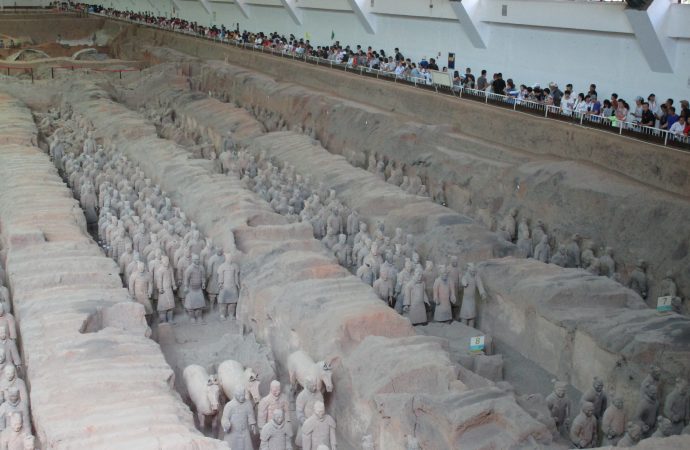The funerary complex of the first Chinese emperor of the Qin dynasty (3 BC) is one of the most famous archaeological sites in the world.
This is, of course, due to the discovery of the terracotta statue army, intended to accompany the emperor in the afterlife. Less well known is the fact that the tomb proper (still not excavated) lies beneath a gigantic, artificial hill of rammed earth. This hill has a square shape, a base side of more than 350 meters and is over 40 meters high, and can easily be called a pyramid.
Notably, all the emperors of the subsequent dynasty, the Western Han, chose to be buried under similar pyramids. These mausoleums are still visible today within the northwestern surroundings of Xian along the Wei River. Including the tombs of the queens and other members of royal families, there are over 40 such “Chinese pyramids.” Of these, only two have been (partly) excavated.
The new study is part of an extensive program of research on the role of astronomy and of the traditional doctrine of feng shui in the Chinese imperial necropolises, and has just been published in Archaeological Research in Asia. The work used simple techniques based on satellite images, together with field surveys to collect new data and, in particular, to study the orientation of the pyramid bases. The Egyptian pyramids are oriented with great precision to the cardinal points by virtue of the strong bonds of the funerary religion of the Egyptian pharaohs with the sky, and in particular with the circumpolar stars.

Although there is no connection with the Egyptian pyramids, the Chinese emperors credited their power as a direct mandate of the heaven, identifying the circumpolar region as a celestial image of the imperial palace and its inhabitants. It was therefore natural to expect the Chinese pyramids, tombs of the emperors, to be oriented to the cardinal points. In this connection, the results of the new study are surprising.
It turns out that these monuments can be classified according to two “families.” One such family comprises monuments oriented with good precision to the cardinal points, as expected. In the other family, there are significant deviations from the true north, all of comparable and all on the same “hand ” (to the west of the north, looking toward the monument).
It is not possible that this second family resulted from errors of Chinese astronomers and architects. Rudimentary compasses existed at that time, but there is no correspondence with paleomagnetic data. The explanation proposed in the article is thus astronomical: The emperors who built the pyramids of the second family did not want to point to the north celestial pole, which at the time did not correspond to any star, but instead to the star to which the pole would approach in the future: Polaris.
All this discourse may look strange at first sight, but the Earth’s axis slowly shifts position in the sky. The Chinese astronomers were almost certainly aware of this. Today, the north celestial pole is identified with Polaris (although in reality the correspondence is not perfect), but at the time of the Han emperors, the pole was still far from Polaris, and with a distance in degrees approximately equal to the deviation of the Chinese pyramids from the geographic north.
Source: Phys.org

































Leave a Comment
You must be logged in to post a comment.